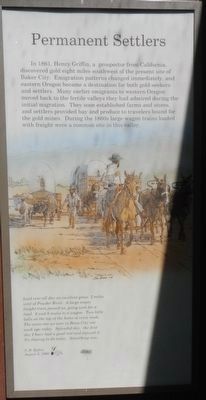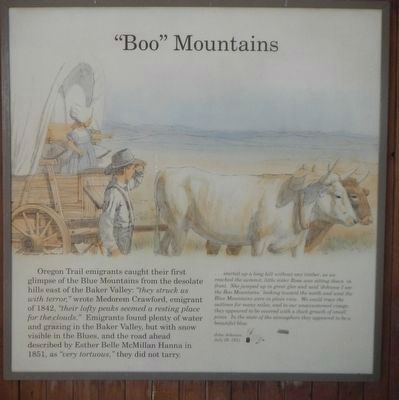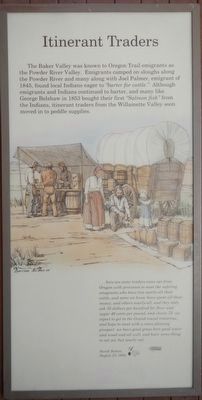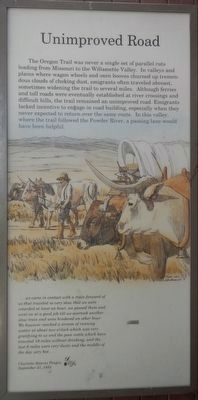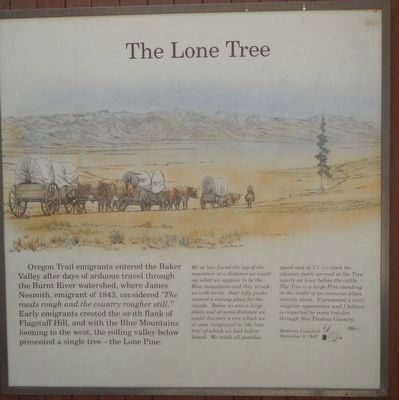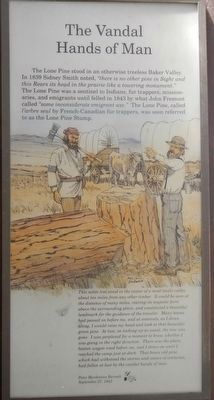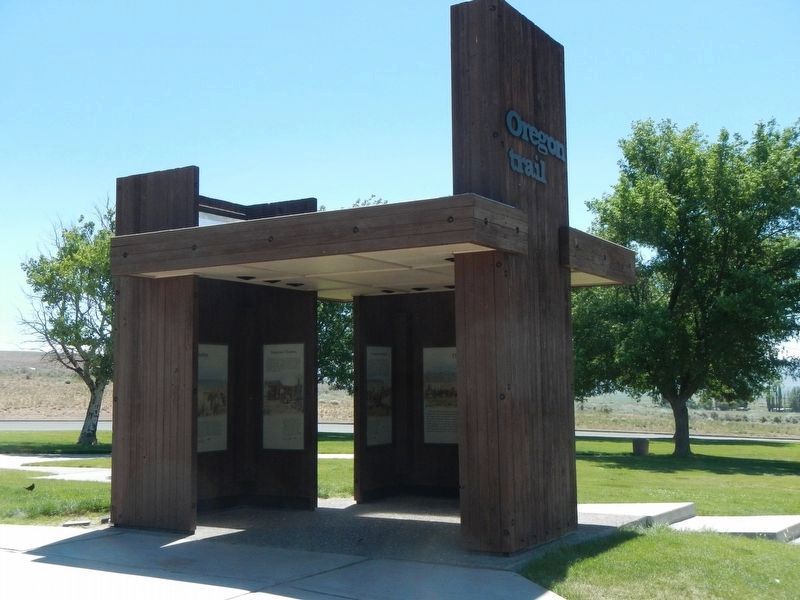Near Haines in Baker County, Oregon — The American West (Northwest)
Baker Valley Rest Area Oregon Trail Kiosk
In 1861, Henry Griffin, a prospector from California discovered gold eight miles southwest of the present site of Baker City. Emigration patterns changes immediately, and eastern Oregon became a destination for both gold-seekers and settlers. Many early emigrants to western Oregon moved back to the fertile valleys they had admired during the initial migration. They soon established farms and stores, and settlers provided hay and produce to travelers bound for the gold mines. During the 1860s large wagon trains loaded with freight were a common site in this valley.
Laid over all day on excellent grass 2 miles west of Powder River. A large empty freight train passed us, going west for a load. 6 and 8 mules to a wagon. Two little bells on the top of the hems of every mule. The same one we seen in Boise City one week ago today. Splendid day the first day I have had a good rest and enjoyed it. No shoeing to do today. Something new. -- S.B. Eakins, August 5 1866
Oregon Trail emigrants caught their first glimpse of the Blue Mountains from the desolate hills east of the Baker Valley: "they struck us with terror," wrote Medorem Crawford, emigrant of 1842, "their lofty peaks seemed a resting place for the clouds." Emigrants found plenty of water and grazing in the Baker Valley, but with snow visible in the Blues, the road ahead described by Esther Belle McMillan Hana in 1851, as "very tortuous," they did not tarry.
"... started up a long hill without any timber, as we reached the summit, little sister Rosa was sitting down in front. She jumped up in great glee and said 'Johnnie I see Boo Mountains,' looking toward the north and west the Blue Mountains were in plain view. We could trace the outlines for many miles, and to our unaccustomed visage, they appeared to be covered with a thick growth of small pines. In the state of the atmosphere they appeared to be a beautiful blue. -- John Johnson, July 29, 1851
The Baker Valley was known to Oregon Trail emigrants as the Powder River Valley. Emigrants camped on sloughs along the Powder River and many along with Joel Palmer, emigrant of 1845, found local Indians eager to "barter for cattle." Although emigrants and Indians continued to barter, and many like George Belshaw in 1853 bought their first "Salmon fish" from the Indians, itinerant traders from the Willamette Valley soon moved in to peddle supplies.
... here are some traders come out from Oregon with provisions to meet the sufering emegrants who have lost nearly all their cattle, and some we know have spent all their money, and others nearly all, and they only ask 35 dollars per hundred for flour and sugar 40 cents per pound, and cheese 75 we expect to get to the Grand round tomorrow, and hope to meet with a more pleasing prospect we have good grass here good after and wood and all well, and have some thing to eat yet, but nearly out. -- Sarah Sutton, August 13, 1854
The Oregon Trail was never a single set of parallel ruts leading from Missouri to the Willamette Valley. In valleys and plains where wagon wheels and oxen hooves churned up tremendous clouds of choking dust, emigrants often traveled abreast, sometimes widening the trail to several miles. Although ferries and toll roads were eventually established at river crossings and difficult hills, the trail remained an unimproved road. Emigrants lacked incentive to engage in road building, especially when they never expected to return over the same route. In this valley, where the trail followed the Powder River, a passing lane would have been helpful.
... we came in contact with a train forward of us that traveled so very slow that we were retarded at least an hour, we passed them and went on at a good job till we overtook another slow train and were hindered an other hour We however reached a stream of running watter at about two o'clock which was very gratifying to us and the poor cattle which have traveled 18 miles without drinking, and the last 8 miles were very dusty and the middle of the day very hot.... -- Charlotte Sterns Pengea, September 21, 1853
Oregon Trail emigrants entered the Baker Valley after days of arduous travel through the Burnt River watersehd, where James Nesmith, emigrant of 1843, considered "The roads rough and the country rougher still." Early emigrants crested the south flank of Flagstaff Hill, and with the Blue Mountains looming to the west, the rolling valley below presented a single tree - the Lone Pine.
We at last found the top of the mountain at a distance we could see what we suppose to be the Blue mountains and they struck us with terror their lofty peaks seemed a resting place for the clouds. Below us was a large plain and at some distance we could discover a tree which we at once recognized as 'the lone tree' of which we had before heard. We made all possible speed and at 7 1/2 o'clock the advance party arrived a the Tree nearly an hour before the cattle. The Tree is a large Pine standing in the midst of an immense plain intirely alone. It presented a truly singular appearance and I believe is respected by every traviler through this Treeless Country. -- Medorem Crawford, September 8, 1842
The Lone Pine stood in an otherwise treeless Baker Valley. In 1839 Sidney Smith noted, "there is no other pine in Sight and this Rears its head in the prairie line a towering monument." The Lone Pine was a sentinel to Indians, fur trappers, missionaries, and emigrants until felled in 1843 by what John Fremont called "some inconsiderate emigrant axe." The Lone Pine, called l'abre seul by French-Canadian fur trappers, was soon referred to as the Lone Pine Stump.
This noble tree stood in the center of a most lovely valley about ten miles from any other timber. It could be seen at a distance of many miles, rearing its majestic form above the surrounding plain, and constituted a beautiful landmark for the guidance of the traveler. Many teams had passed on before me, and at intervals, as I drove along, I would raise my head and look at that beautiful green pine. At last, on looking up as usual, the tree was gone. I was perplexed for a moment to known whether I was going in the right direction. There was the plain, beaten wagon road before men, and I drove on until I reached camp just at dark. That brave old pine, which had withstood the storms and snows of centuries, had fallen at last by the vandal hands of man. -- Peter Hardeman Burnett, September 27, 1843
Erected by Oregon Trail Coordinating Council (OTCC).
Topics. This historical marker is listed in these topic lists: Roads & Vehicles • Settlements & Settlers.
Location. 44° 54.834′ N, 117° 49.146′ W. Marker is near Haines, Oregon, in Baker County. Marker is on Interstate 84 at milepost 293 near Medical Springs Highway (Chandler Lane) (Oregon Route 203), on the right when traveling west. Touch for map. Marker is in this post office area: Haines OR 97833, United States of America. Touch for directions.
Other nearby markers. At least 8 other markers are within 9 miles of this marker, measured as the crow flies. Cattle Drives (approx. 5.9 miles away); "The 1880's Park" in Haines (approx. 5.9 miles away); Chandler Cabin (approx. 5.9 miles away); The Lone Tree of the Oregon Trail (approx. 7.7 miles away); Oregon Trail Memorial (approx. 8 miles away); The Wagon Encampment (approx. 8.2 miles away); Ruts of the Oregon Trail (approx. 8˝ miles away); The Lure of Gold (approx. 8˝ miles away). Touch for a list and map of all markers in Haines.
More about this marker. This Oregon Trails kiosk is located at the Baker Valley Rest Area.
Credits. This page was last revised on December 27, 2017. It was originally submitted on December 10, 2017, by Barry Swackhamer of Brentwood, California. This page has been viewed 281 times since then and 29 times this year. Photos: 1, 2, 3, 4, 5, 6, 7. submitted on December 10, 2017, by Barry Swackhamer of Brentwood, California.
